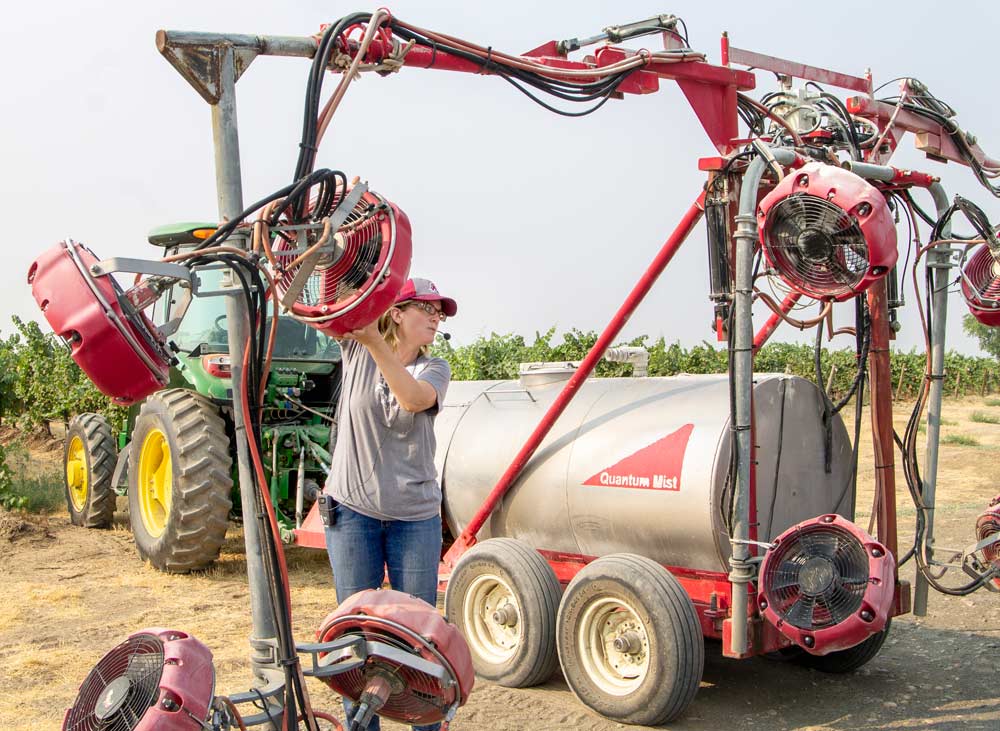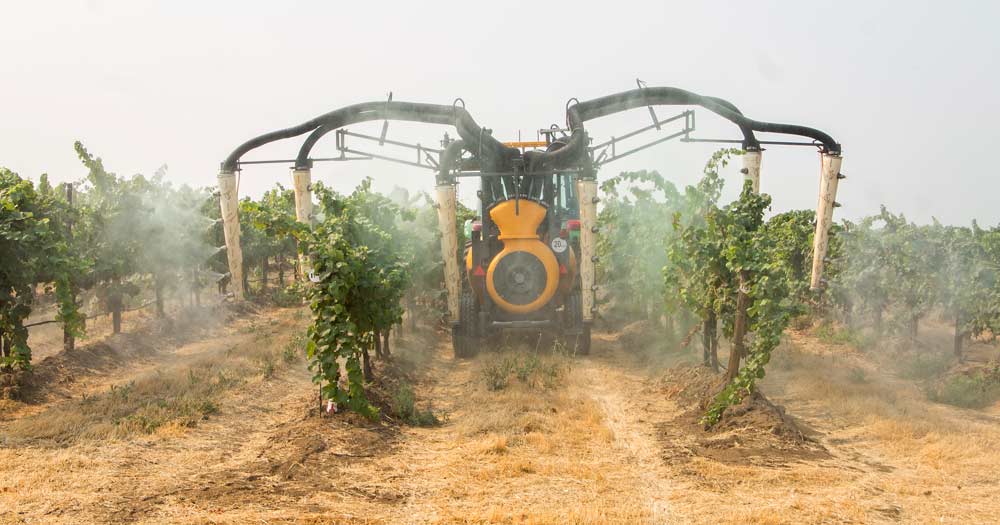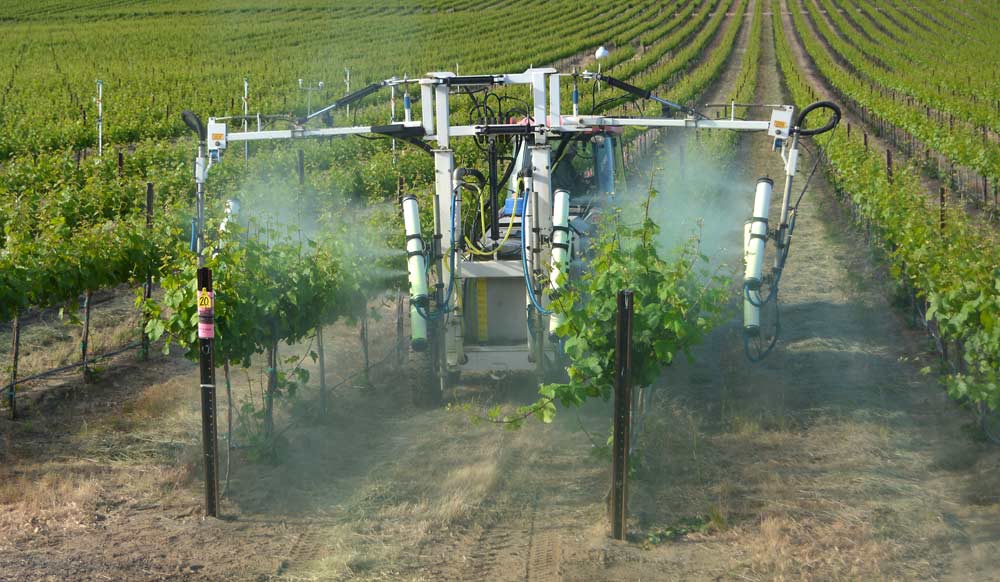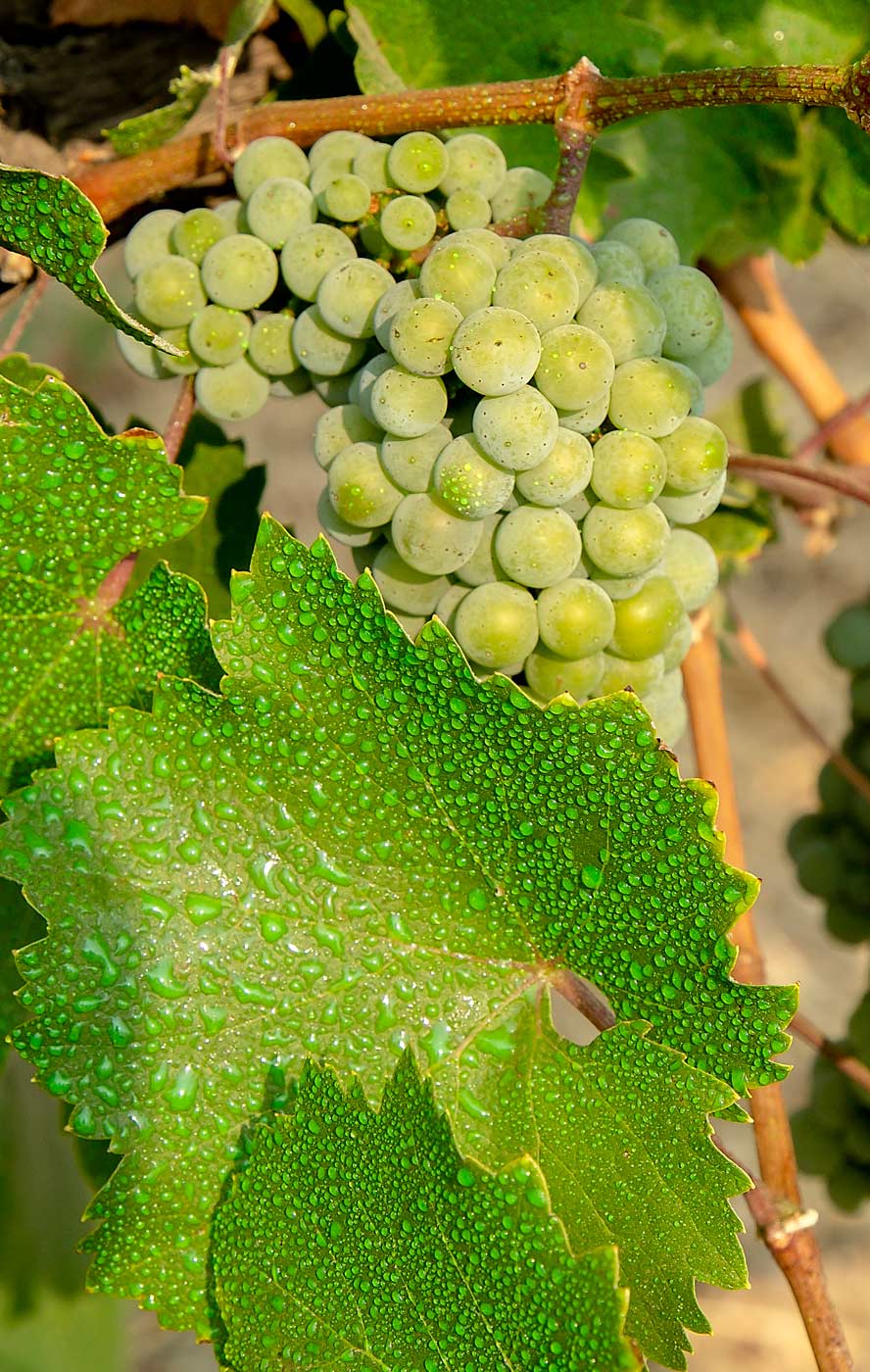
Washington State University Extension Specialist Gwen Hoheisel discusses how to position the heads on a Quantum Mist sprayer for optimum performance during a viticulture and enology field day in 2017, in a commercial vineyard near Paterson, Washington. (Shannon Dininny/Good Fruit Grower)
A good application means getting the best performance out of your spray products, but for every technology on the market, achieving that optimum performance looks a little different.
That’s why Washington State University Extension Specialist Gwen Hoheisel has spent the past three seasons evaluating directed air, pneumatic and electrostatic vineyard sprayers — so she can help growers understand and optimize the technology they are using.
Her work on airblast sprayers will continue this season, but Hoheisel presented her findings on the Quantum Mist, Gregoire pneumatic and OnTarget sprayers to the Washington State Wine Commission’s research committee — which funded her efforts — in January. She’s also been sharing the results with growers at field days and extension events.
All three sprayers were evaluated on deposition, in-field drift and disease control. Using large field plots, Hoheisel and her colleagues studied season-long spray programs for disease control and one-time sprays to track deposition with spray cards placed in the canopy, on the vineyard floor and on high poles that collect the bright green dye used in the sprayer.
The sprayers were tested in different vineyards with different viticultural practices, so the results of these assessments should not be used to compare the sprayers; instead, they’re intended to help growers optimize the performance of the technology they are using, Hoheisel said. In addition, the applied gallons per acre and results will vary according to canopy size, weather and machine.
With the Quantum Mist, which was tested in a vineyard with a modified VSP system, 95 percent of the spray deposition landed in the canopy in the early season and 98.5 percent in the late season. The sprayer ran at 50 gallons per acre in the early season and 75 gallons per acre in the later season. More of the deposition ended up in the top canopy zone than the bottom, especially later in the season.
This deposition pattern may have more to do with the canopy management than the sprayer itself, Hoheisel said.
“Our viticultural practices are interacting with our spraying practices. If a lot of leaf pulling and shoot thinning occurs, then less plant material is present to create turbulence, and so the amount of air coming in is not well matched with our fruiting zone,” she said.
“Alternatively, if the vineyard has not done this, there could be many leaves that are shading the clusters, which leads to less deposition.”
As for the spray that didn’t catch in the canopy, most went to the vineyard floor, one row over during the late season or within the first two rows in the early season. Aerial drift was practically nonexistent with the late-season full canopy, however, in the early season, of the 2 percent of deposition that went off target above the canopy, 60 percent landed in the first row from the sprayer.
To keep the Quantum Mist at peak performance, Hoheisel recommends — as does the manufacturer — keeping the nozzles symmetrical, verifying that the rate controller speed matches the tractor and that the GPS is in a good location, such as on top of the sprayer. The nozzles can tilt and move, which is a benefit, but that means it’s important to ensure they are tightened in the position you want them.

The Gregoire pneumatic sprayer runs during a demonstration about optimizing sprayer performance during a viticulture and enology field day Aug. 10, 2017, in a commercial vineyard near Paterson, Washington. (Shannon Dininny/Good Fruit Grower)
With the Gregoire pneumatic, which was also tested in a vineyard with a modified VSP system, Hoheisel found almost identical levels of deposition in the canopy in both the early and late season at 97 percent. The sprayer ran at 25 gallons per acre in the early season and 50 gallons per acre later.
The remaining drift went to the vineyard floor. Early in the season, the sprayer hit the bottom canopy more than the top, due to how the sprayer is calibrated for canopy size by using just three nozzles instead of all five, Hoheisel said.
Although the amount of aerial drift was tiny — just 0.1 percent — it drifted farther during the late season, while in the early season it all landed just one row from the sprayer.
“These droplets are so small that with temperature high and relative humidity low here, that means by the time we get to 84 degrees, these droplets can get even smaller and drift further,” she said.
As for getting the best performance out of your Gregoire, Hoheisel said that the inline discs and rubber gaskets be replaced and nozzles cleaned regularly.
The windsocks should be aligned at 15 to 20 degrees to the rear of the sprayer, facing into the canopy, and tire pressure checked to ensure that the sensor in the wheel is providing accurate data.

The OnTarget sprayer creates an electrostatic charge that can help spray particles stick to their destination and improve coverage. (Courtesy Margaret McCoy/Washington State University)
Lastly, the OnTarget sprayer, which was tested in a vineyard with a tight VSP system, had better canopy deposition early in the season, with 92 percent landing in the canopy and 7.4 percent of the deposition on the vineyard floor. In the late season, 80 percent of the deposition hit the canopy, 16 percent landed on the floor, and 4 percent was recorded as aerial drift. The thinner, narrower canopy of this vineyard definitely played a role in those drift levels, she said.
“It gets really even cover with all the nozzles and does well penetrating the interior of the canopy,” Hoheisel said. The sprayer ran at 20 gallons per acre, the maximum capacity, in both early- and late-season tests.
Of the floor drift observed by the researchers, more than 80 percent was found just one row over. The aerial drift traveled farther: about 50 percent landed one row away, while 30 percent hit two rows away. The remaining 14 to 21 percent landed the third row over.
The droplet size with this sprayer needs to be quite small for the electrostatic charge to be effective. Running the sprayer at rates above 20 gallons per acre can result in “slobber” and a weak charge, Hoheisel said.
People also tend to overestimate the effect of the electrostatic charge, she said. It’s effective within several centimeters of the target clusters, but it won’t pull material from several feet above the canopy. So, you still need to target the nozzles into the canopy and check the charge as routine maintenance, she added.
When it comes to the disease control tests, each sprayer was used all season in the test plots to control powdery mildew. Looking at powdery mildew incidence and severity across each canopy, there was no significant differences in where the mildew was found. That means all three sprayers worked well to provide consistent coverage, Hoheisel said. •

Fluorescent green pyranine dye shows the spray pattern on the canopy after a demonstration at a viticulture field day. (Shannon Dininny/Good Fruit Grower)
Final phase will evaluate nozzle styles, setups
This summer, the final phase of this project evaluates airblast sprayers with different nozzle styles and setups. Understanding the relationship with airblast droplet size and drift risk is important as it’s the basis for the required size of application exclusion zones under the new federal Worker Protection Standards, which aim to prevent pesticide exposure via unintended drift. Larger droplet sizes only require a 25-foot exclusion zone, but small, fine airblast droplets require a 100-foot exclusion, Hoheisel said. So, she’s interested in seeing if growers can get sufficient, efficient coverage with those larger droplets.
—by Kate Prengaman






Leave A Comment